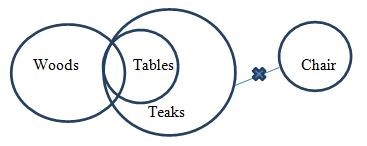Question
Statements: Some woods are tables. All
tables are teaks. No teak is a chair. Conclusions: I. Some woods are teaks. II. Some woods are not chairs. III. Some tables are not chairs. In each question below are given three statements followed by three conclusions numbered I, II and III. You have to take the two given statements to be true even if they seem to be at variance with commonly known facts and then decide which of the given conclusions logically follows from the two given statements, disregarding commonly known facts.Solution
Some woods are tables (I) + All tables are teaks (A) ⇒ Some woods are teaks (I) + No teak is a chair(E) ⇒ Some woods are not chairs(O) . Hence, conclusion I and II follows. All tables are teaks(A) + No teak is a chair(E) ⇒ No table is a chair(E) ⇒ Conversion ⇒ Some tables are not chairs(O). Hence, conclusion III follows. Alternate Method: Minimum possibility: 
Where is Akbar’s Mausoleum situated ?
Disguised unemployment exists primarily in the ________ sector in our country.
World tribal day is celebrated on _____________ ?
Profit and Loss Account is prepared:
Which of the following is/are correct regarding to National food security act 2013?
I. It covers 75% of the rural popula...
On dividing a³ + b³ + c³ – 3abc by a + b + c, the quotient obtained is
A completes a work in 15 days, B completes the same work in 8 days while B and C jointly complete the same work in 4 days. If A and C jointly complete t...
Who is considered an inter-state migrant worker under the OSH Code 2020?
Carbon is able to form stable compounds because of:
Which one of the following memories is extremely fast and acts as a high-speed buffer between the CPU and the main memory?


